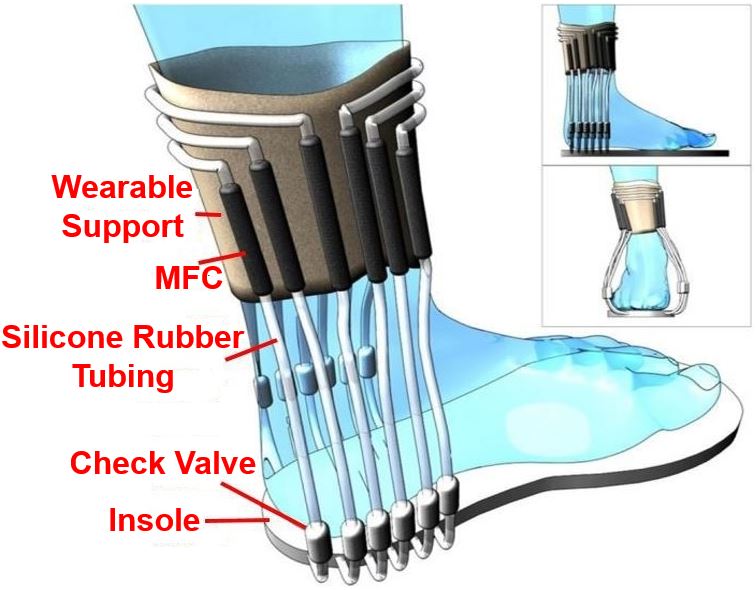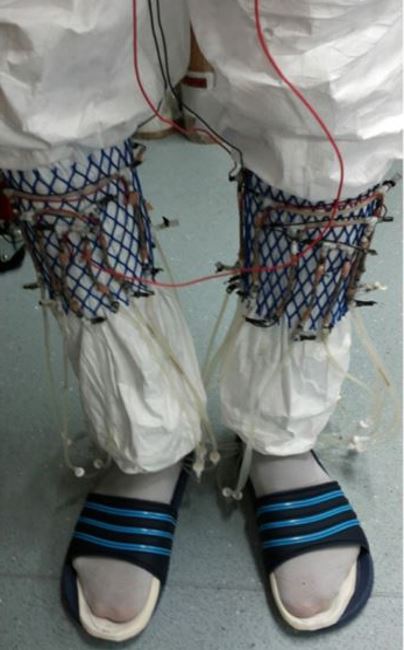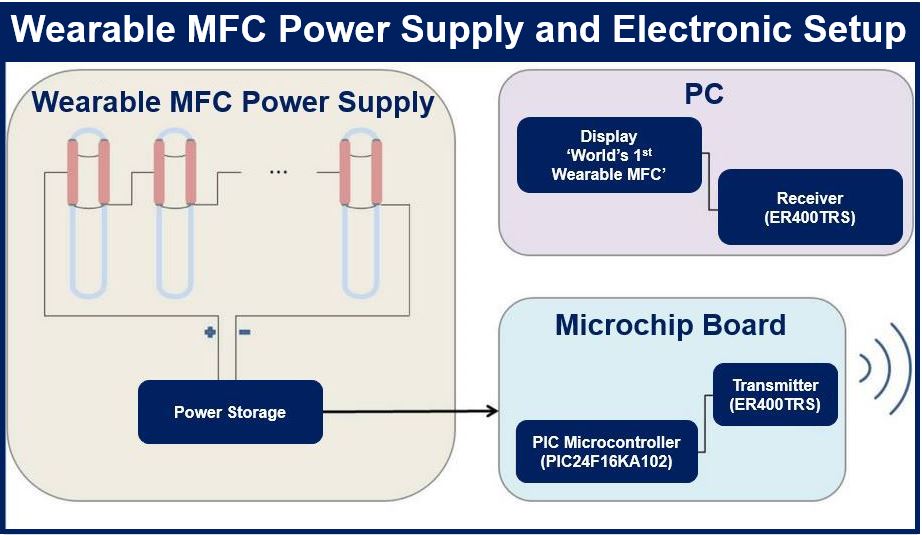A pair of wearable urine socks can generate electricity and power a wireless transmitter to send a Wi-Fi signal to a personal computer. The wearer’s walking movements pump the urine over miniaturised microbial fuel cells (MFCs) which fuels them, said a team of scientists from the Istituto Italiano di Tecnologia in Italy and the University of the West of England (UWE Bristol).
Study leader, Professor Ioannis Ieropoulos, who works at the Bristol BioEnergy Centre, part of UWE Bristol, and colleagues wrote about their experiment in the academic journal Bioinspiration and Biomimetrics.
According to the scientists, their system is the first self-sufficient one powered by a wearable energy generator based on microbial fuel technology.
 A drawing of the manual pumping system in the sock designed and developed to circulate urine through the miniaturised microbial fuel cells. (Image: iopscience.iop.org)
A drawing of the manual pumping system in the sock designed and developed to circulate urine through the miniaturised microbial fuel cells. (Image: iopscience.iop.org)
MFCs represent an entirely new method of renewable energy recovery – the direct conversion of organic matter to electric power using bacteria. While for some this may sound more like sci-fi than science fact, researchers have long known that bacteria could be used to generate electricity.
Prof. Ieropoulos and colleagues explained how in their laboratory-based experiment, MFCs were embedded within a pair of wearable socks and supplied with fresh urine that circulated as the wearer walked.
No mains electricity needed to pump the urine
Until this experiment was carried out, continuous-flow MFCs required that the pump be connected to mains electricity to circulate the urine over the microbial fuel cells. Prof. Ieropoulos and team managed to get all the electric power from the action of walking.
The manual pump, which was based on a human’s walking action and a simple fish circulatory system, made the urine pass over the MFCs, thus generating energy.
Continuous fluid push-pull was accomplished by placing soft tubes under the heel part of the socks, plus the walking activity of the person who was wearing them.
This wearable microbial fuel cell system managed to run a wireless transmission board that sent a message via Wi-Fi every two minutes to a PC-controlled receiver module.
 If you wear the urine socks and walk about, they will generate electricity that can charge a smartphone or send Wi-Fi signals to a PC. An amazing renewable source of power. (Image: iopscience.iop.org)
If you wear the urine socks and walk about, they will generate electricity that can charge a smartphone or send Wi-Fi signals to a PC. An amazing renewable source of power. (Image: iopscience.iop.org)
An entirely self-sufficient system
Prof. Ieropoulos explained:
“Having already powered a mobile phone with MFCs using urine as fuel, we wanted to see if we could replicate this success in wearable technology. We also wanted the system to be entirely self-sufficient, running only on human power – using urine as fuel and the action of the foot as the pump.”
“This work opens up possibilities of using waste for powering portable and wearable electronics. For example, recent research shows it should be possible to develop a system based on wearable MFC technology to transmit a person’s coordinates in an emergency situation.”
“At the same time this would indicate proof of life since the device will only work if the operator’s urine fuels the MFCs.”
 A block diagram of all the described components, emphasising the electrical connections (Image: iopscience.iop.org)
A block diagram of all the described components, emphasising the electrical connections (Image: iopscience.iop.org)
MFCs, which use bacteria to produce electrical energy from waste fluids, draw on the biochemical energy used for microbial growth. This is then converted directly into electricity.
The authors said their technology can use all types of organic waste and turn it into usable electric power without the need for fossil fuels. It is an extremely cheap and valuable green technology.
The Bristol BioEnergy Centre together with Oxfam recently launched a prototype urinal that uses urine power – also known as pee-power or wee-power – technology to light cubicles in refugee camps (see YouTube video below).
The authors wrote in an Abstract in the journal:
“A wireless programmable communication module, engineered to operate within the range of the generated electricity, was employed, which opens a new avenue for research in the utilisation of waste products for powering portable as well as wearable electronics.”
Reference: “Self sufficient wireless transmitter powered by foot-pumped urine operating wearable MFC,” J Greenman, M Taghavi, A Stinchcombe, V Mattoli, I A Ieropoulos, L Beccai, B Mazzolai and C Melhuish. Bioinspiration & Biomimetics. 10th December, 2015. DOI:10.1088/1748-3190/11/1/016001.
Video – Pee-Power Urinal
A prototype urinal is the result of a partnership between scientists at UWE Bristol and Oxfam. They hope the pee-power technology will light cubicles in refugee camps, which are often dark and dangerous places particularly for women.

